Pigeon Associated Legislation in USA and Canada
Pigeons hold a unique dual status as pests and protected creatures, greatly influencing the legislative landscape.
Federal, state and local laws intersect in the USA and Canada to create a complex legal environment governing pigeon-related activities such as feeding, breeding, containment and control measures.
Moreover, with the increasing recognition of animal welfare, there is a growing emphasis on the humane treatment of pigeons, further complicating the regulatory picture.
In recent years, the increasing urbanization and globalization of societies have intensified the need for effective and adaptable pigeon-associated legislation.
The cohabitation of humans and pigeons in densely populated urban areas has raised concerns about public health risks associated with pigeon droppings and the potential transmission of diseases.
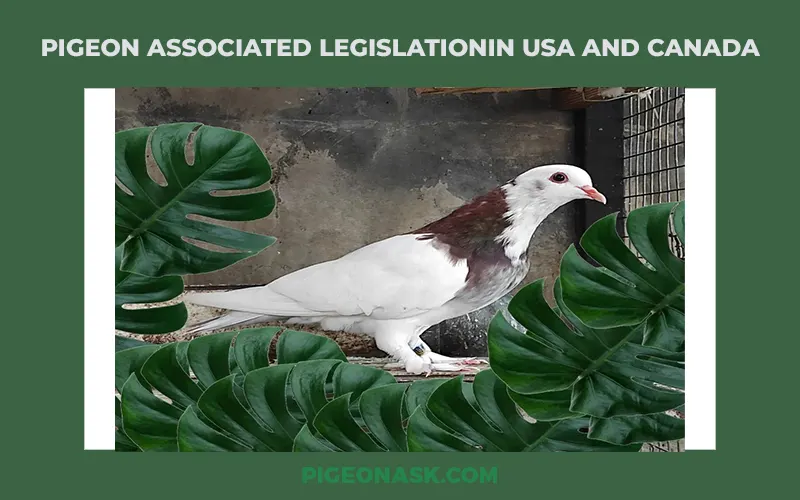
Simultaneously, the cultural and historical significance of pigeons in various communities necessitates a nuanced approach to regulation that respects the diverse perspectives on these birds.
This article analyzes and compares the legislative frameworks in the USA and Canada related to pigeon management, control and protection.
The discussion will also include historical context, key motivations and situations that have shaped these regulations
Want to learn more about pigeon:
Pigeon Related Problems in the USA and Canada
The number of pigeon-related issues in American and Canadian cities has escalated recently for various reasons.
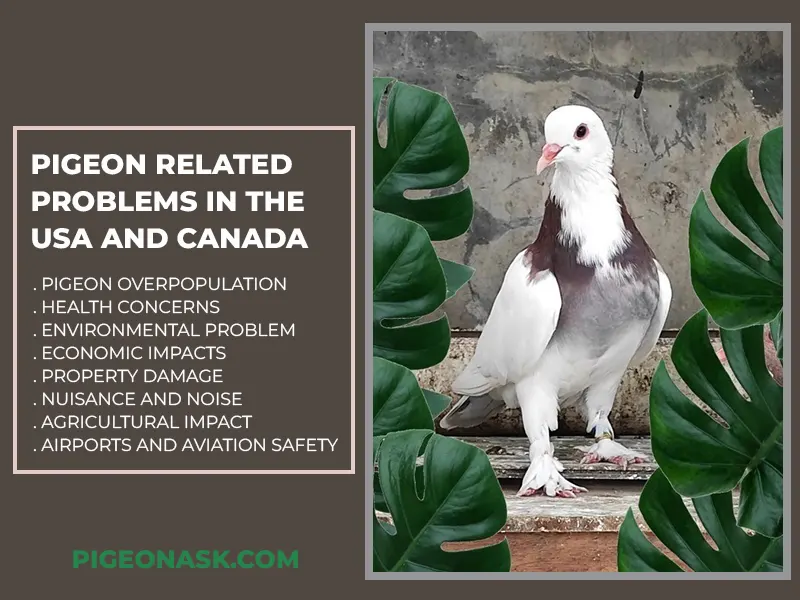
Here is an overview of the issues associated with pigeon overpopulation and its various impacts on human health, environment, economy and infrastructure.
Pigeon Overpopulation
Urban locations provide pigeons with plenty of food sources and places to build nests. Cities often provide easier access to resources than rural areas, which has led to a huge increase in urban pigeon populations.
With few natural predators and a steady supply of discarded food, pigeon populations can grow unchecked, leading to overpopulation.
Female pigeons reproduce at an alarming rate, with each female capable of giving birth to 48 squabs in a year.
Additionally, pigeons have a long lifespan of up to 15 years. Some in captivity can live over 30 years. A well-fed pigeon can produce around 11.5 kilograms of hazardous droppings annually.
Health Concerns
Pigeons are carriers of various pathogens and can transmit diseases to humans through their droppings, feathers and nests, posing potential health risks.
Histoplasmosis, Cryptococcosis, Salmonella, Toxoplasmosis and psittacosis are among the diseases associated with pigeon droppings. The wild pigeon may transmit more than 40 illnesses to humans.
Accumulations of pigeon droppings can also harbor fungal spores that can lead to respiratory ailments in humans. In addition, pigeons can attract other pests, such as mites, ticks and fleas, further endangering public health.
Environmental Problem
In urban settings, pigeons have the potential to upset the natural equilibrium. High pigeon populations can displace native bird species and upset the local ecosystem.
Their droppings are acidic and can damage vegetation and spoil water sources and air, leading to broader environmental degradation.
Economic Impacts
The economic impact of pigeon invasion can be significant. Businesses may need to clean pigeon droppings regularly, install pigeon deterrents, or repair pigeon-related damage, which incurs considerable costs.
In addition, the presence of pigeons can be off-putting to customers, potentially affecting business revenue.
Invasive bird species, including the common pigeon, have been reported to deal damages to property and agriculture, with an estimated $28 million in damages reported to Wildlife Services over an 8-year period.
Property Damage
Buildings are frequent locations for pigeon nests, which can cause property damage. Their acidic droppings can erode building materials, clog drains and gutters, create moisture problems and stain surfaces.
Cleaning and maintenance to manage pigeon problems can be expensive for property owners. The New York Times reported that pigeon-related damage in America is estimated to cost $1.1 billion annually.
Plus, their droppings damage the finish of buildings and automobiles, creating expensive problems for warehouse management when customers refuse to accept contaminated goods.
Nuisance and Noise
The presence of large pigeon populations in urban areas can be a nuisance due to noise, droppings and aggressive scavenging behavior.
Pigeons may also become aggressive during their breeding season, adding to the inconvenience for residents.
Agricultural Impact
Pigeons are known to feed on agricultural crops, which can lead to yield losses for farmers.
They can consume or contaminate a significant amount of grains and other foodstuffs, especially in rural areas near urban centers and this leads to economic losses.
The control costs of pigeons are estimated to be at least $9 per pigeon per year.
Airports and Aviation Safety
A major risk to aviation safety can come from pigeons and other birds.
The presence of pigeons near airfields has increased and measures such as the use of imitation hawk-kites have been explored to reduce the frequency of bird flyovers at airports.
Bird strikes have caused aircraft accidents and incidents, leading to significant human safety concerns and financial losses for the aviation industry.
Airports invest in bird control measures, including habitat modification, falconry and acoustic devices, to reduce the risk of bird strikes.
Historical Perspective on Pigeon Legislation and Regulation in the USA
The concept of pigeon legislation and regulation in the United States is unique, complex and has a historical context. They have roots in various aspects of American history, such as agriculture, post services and public health.
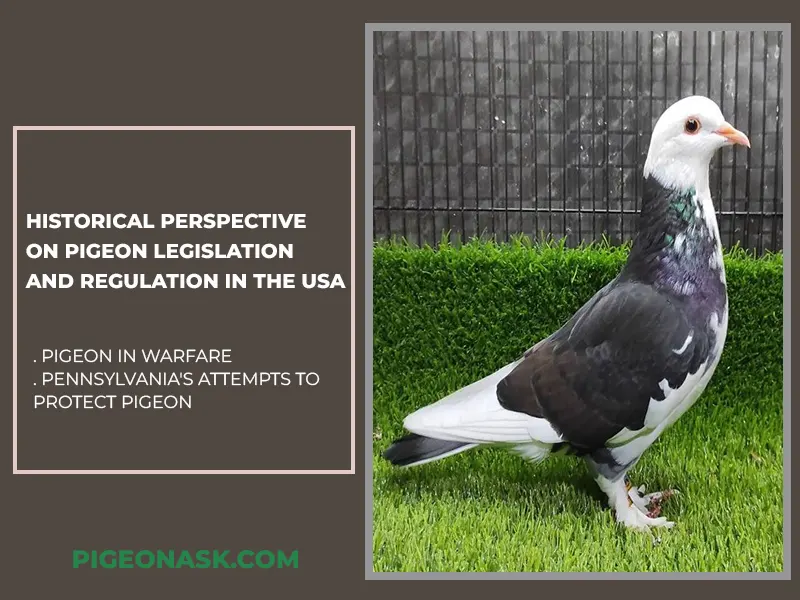
Over the years, an incensed debate has emerged revolving around the regulation, protection and sometimes vilification of pigeons in the United States.
Pigeon in Warfare
Probably, the most embraced role of pigeons in America’s history is their service as messengers during significant wars, including the Civil War and World War I and II.
During World War I and II, the value of pigeons increased drastically. The U.S. Army Pigeon Service was established to train homing and carrier pigeons to carry vital information.
According to a report by the National Museum of American History, nearly 56,000 pigeons were trained and dispatched during World War II. Their service became invaluable and saved thousands of lives during the war.
During the 20th century, laws were passed to protect homing pigeons used in wartime communication, such as the 1918 U.S. federal law that prohibited entrapping and killing any homing pigeon owned by the U.S.
This policy remained in various forms until it was repealed in 1990.
Pennsylvania’s Attempts to Protect Pigeon
Pennsylvania and Michigan were among the first states to pass laws to protect passenger pigeons. The extinction of this pigeon led to the realization of the need for strong conservation laws.
In response to the impending extinction of the passenger pigeon, Congress passed the Lacey Act to help states protect resident species.
Pennsylvania’s General Assembly adopted a legislative package consolidating wildlife laws in 1875, which included making it illegal to discharge a firearm within a quarter mile of wild pigeon rookery and to shoot at roosting pigeons.
Doing so would have fined you $25, but the measure was largely ignored.
The extinction of the passenger pigeon is considered a poignant example of the clash between human interests and nature, leading to the realization of the need for conservation laws.
In the 19th century, laws were also enacted to protect pigeons from being frightened or killed. For example, a 1951 law in Massachusetts prohibited frightening pigeons, with a penalty of up to a month in prison and a $20 fine.
This law reflected the historical context where pigeons were a food source and used in target shooting.
Federal Legislation Concerning Pigeons in the USA
In the United States, there have been federal laws and regulations concerning pigeons, particularly related to homing and racing pigeons.
These pieces of legislation protect the species’ habitats and determine how these birds can be managed, controlled and used.
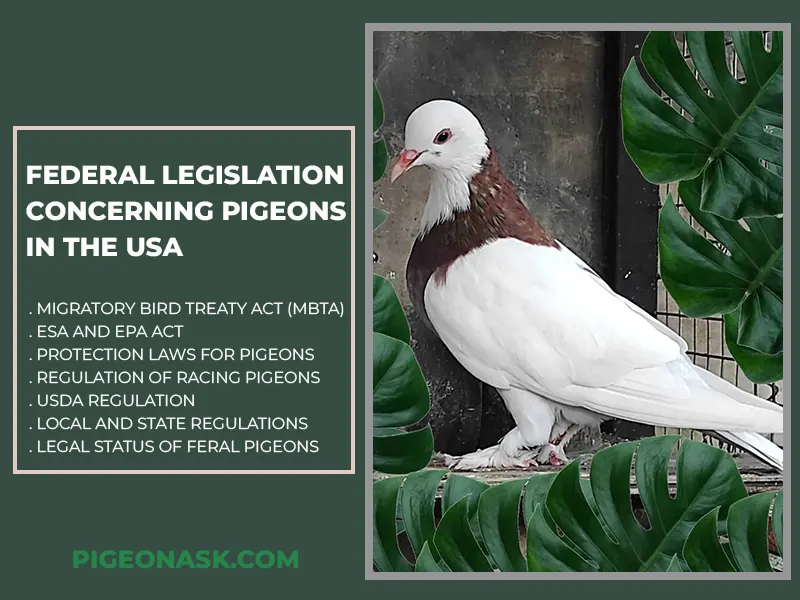
Here are the federal legislation and regulations concerning pigeons in the USA –
Migratory Bird Treaty Act (MBTA)
One key piece of federal legislation relevant to pigeons is the Migratory Bird Treaty Act (MBTA) of 1918.
This legislation, enforced by the U.S. Fish and Wildlife Service, makes it illegal to pursue, hunt, kill, capture, possess, buy, sell, trade, or transport any migratory birds, their eggs, parts and nests, except as permitted by regulations issued under this Act.
The MBTA applies to migratory bird species that are native to the United States or U.S. territories.
Although initially intended to protect migratory birds crossing international borders, this Act was interpreted to include almost all bird species except for a handful classified as non-native, game, or pest birds, such as the Rock and Feral pigeon.
ESA and EPA Act
The U.S. Environmental Protection Agency (EPA) regulates pesticides that may be harmful to pigeons, other birds and ecosystems under the Federal Insecticide, Fungicide and Rodenticide Act (FIFRA).
Another significant piece of federal legislation is the Endangered Species Act (ESA) 1973. This law helps to protect threatened and endangered species and their habitats.
If a pigeon species were to become endangered, their protection would fall under this Act. The ESA limits actions that could harm endangered species and penalizes violations of these restrictions.
Protection Laws for Pigeons
Despite the widespread protections for birds, some federal and state laws allow for control or management of nuisance pigeon populations.
The specifics vary by state and situation, so it’s essential and wise to consult state wildlife agencies to be aware of wildlife control federal laws and local guidelines.
In 1918, a U.S. federal law was passed to prohibit entrapping and killing any homing pigeon owned by the U.S. This policy remained in place in various forms until it was repealed in 1990.
Regulation of Racing Pigeons
The American Racing Pigeon Union has been involved in monitoring legislation that may impact the sport on behalf of pigeon fanciers nationwide.
There have been discussions and legal actions related to the regulation of racing pigeons under the Animal Welfare Act (AWA).
USDA Regulation
The USDA has been involved in the regulation of birds not bred for research, which could potentially include racing pigeons.
There have been ongoing legal and regulatory activities in this area, with potential implications for pigeon welfare and related enforcement.
Local and State Regulations
Some state and local governments have their own ordinances regarding the harboring and keeping of pigeons.
For example, in Parma Heights, Ohio, there are specific ordinances related to harboring pigeons, including the requirement for a license and penalties for violations.
These laws also set conditions for keeping domestic pigeons and ensuring their housing and care.
Legal Status of Feral Pigeons
Feral pigeons are not protected by federal law MBTA 1918 and most states do not afford them protection. However, state and local laws should be consulted before any control measures are taken.
National Legislation Related to Pigeons in Canada
Canada holds a unique position when it comes to pigeon legislation. Pigeons, specifically of the rock dove variety, are not native to Canada, having been introduced from Europe.
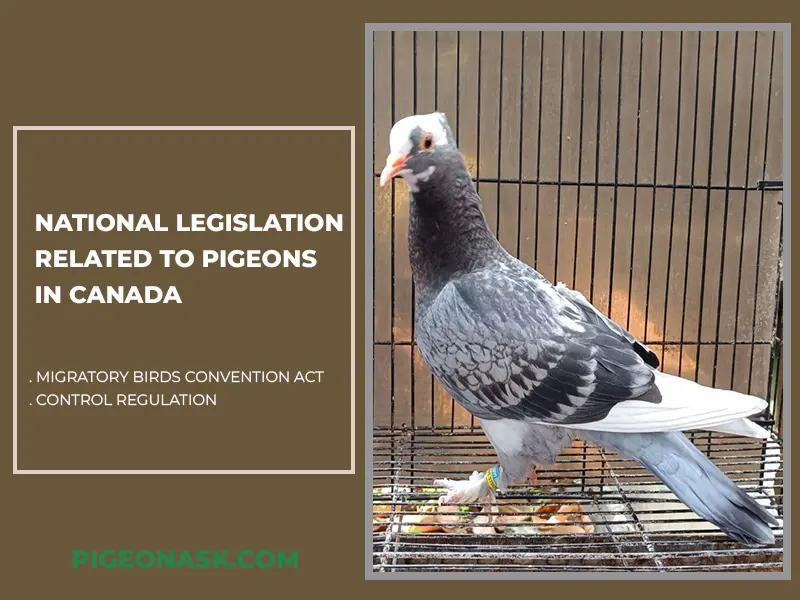
Now, they have proliferated in numerous urban and suburban areas throughout the country. Therefore, governments of different levels have established various rules and regulations to manage pigeon populations and pigeon-related activities.
Migratory Birds Convention Act
The MBCA 1994 is the primary legislation related to bird protection in Canada.
This Act was passed in 1917 and updated in 1994 and 2005 to implement the Migratory Birds Convention. Most species of birds in Canada are protected under this Act except pigeons.
The Canadian federal government has the authority to pass and enforce regulations, known as the Migratory Birds Regulations, to protect bird species included in the Convention.
This Act protects most species of birds in Canada and it requires that certain criteria be met for a species to be listed as protected under the MBCA.
This Act also outlines specific activities that require a permit, such as capturing, killing, taking, injuring, or harassing a migratory bird, as well as disturbing nests or eggs.
Additionally, the Act places legal obligations on individuals and organizations to prevent harm to birds, including unintentional harm such as collisions with buildings.
Control Regulation
As pigeons are not directly protected under the MBCA, because they are not native or naturally occurring in Canada and are not included in the list of protected species.
Regarding pigeon control and removal, there are various techniques for excluding pigeons from infested structures, including structural modification, falconry, trapping and bird netting.
Additionally, local ordinances in certain jurisdictions may prohibit the harboring of pigeons within the city, with violations leading to fines and forfeitures.
In specific locations such as North Bay, Ontario, feeding wildlife is prohibited.
Fines ranging from $100-$365 are imposed for feeding pigeons or depositing food likely to attract pigeons and obstructing or failing to comply with an order can result in a large penalty.
These regulations and penalties highlight the importance of understanding and complying with local laws and ordinances related to pigeon control and activities to avoid potential legal consequences.
Are Pigeons Protected in the USA and Canada?
Pigeons, specifically rock pigeons (Columba livia), are among the most common birds found in urban environments in the United States and Canada.
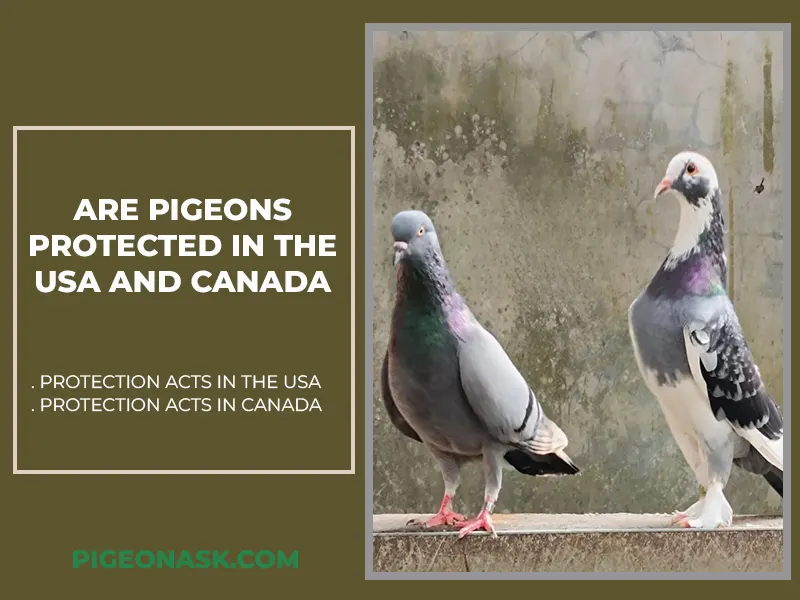
However, the level of protection they receive varies by location and depends on several factors, including species status, local laws and migratory bird regulations.
Protection Acts in the USA
In the United States, the Migratory Bird Treaty Act (MBTA) of 2023 protects over 1100 birds, making it illegal to hunt, take, capture, kill, or sell birds listed therein.
However, the rock pigeon is not protected under the MBTA because it is not considered a native species.
It was introduced to North America from Europe. As a result, pigeons do not have the same federal protections as many other birds.
Nonetheless, individual states and municipalities may have their regulations and penalties regarding the treatment of pigeons.
For instance, some cities have laws against feeding pigeons, while others may have measures for humane control of pigeon populations.
Protection Acts in Canada
In Canada, the rock and feral pigeon are not covered and protected by the Migratory Birds Convention Act 1994, which, like the U.S. MBTA, protects native migratory bird species.
This means that, federally, there are no protections specifically for these pigeons in Canada either.
However, like in the U.S., every state of Canada has a Wildlife Act that ensures some safety and protection for wild pigeons or controls their management humanely.
These could include rules against poisoning or using inhumane methods to deter pigeons.
Both countries generally focus their bird protection efforts on native and endangered species, so pigeons, being neither of these, are often managed as part of urban wildlife control rather than conservation.
Future of Pigeon Associated Legislation and Regulation
As urbanization continues to increase, the interaction between pigeons and humans is becoming more common, leading to debates concerning their management, conservation and related public health risks.
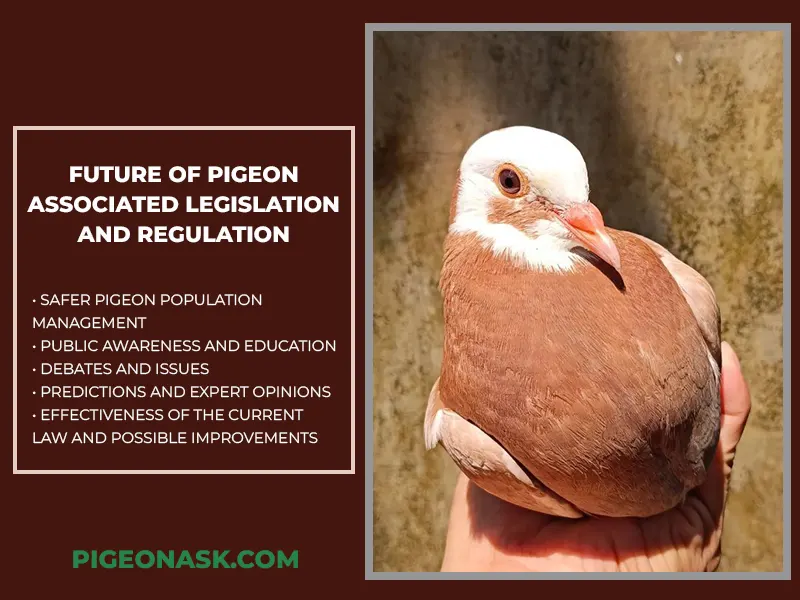
This is where the future of pigeon-associated legislation and regulation comes into play.
Safer Pigeon Population Management
Pigeons are often the subject of environmental legislation due to their impact on city cleanliness, the spread of diseases and property damage.
One of the most famous examples of this is in New York City, where it is illegal to feed pigeons in parks and public spaces, applying fines for violations.
Similar regulations are in place in other cities worldwide in an effort to control pigeon populations, reduce their negative impacts on urban environments, or safeguard human health.
Moving forward, policies and regulations relating to pigeons are expected to evolve in response to changing urban landscapes and understandings of pigeon behavior.
Future legislation may focus on creating humane responses to the interaction between these birds and humans, utilizing innovative approaches toward pigeon population management.
Public Awareness and Education
There could be an increasing emphasis on the role of public education in legislation and regulations.
This could aim to increase public awareness about the ecology and behavior of pigeons and the potential risks associated with them and encourage community involvement in their management.
On the flip side, pigeon keepers and enthusiasts are also looking forward to regulations that protect their interests.
In some countries, pigeon racing and breeding are treasured pastimes that demand relevant legislation. This ensures that they can continue to be practiced in a way that is safe for both the birds and their keepers.
Debates and Issues
The current debates and issues in terms of pigeon-associated legislation revolve around issues such as animal rights, public health and urban nuisance.
From an animal rights perspective, activists argue that anti-pigeon laws and regulations are cruel and inhumane, oftentimes leading to culling or poisoning of the birds.
Activists argue that anti-pigeon laws and regulations are cruel and inhumane. They claim that pigeon shooting is already illegal under the state’s anti-animal cruelty statute.
Additionally, they argue that regardless of the method used, the killing of pigeons is inhumane.
On the other hand, public health advocates highlight the potential diseases pigeons can carry and property owners often decry the damage and mess pigeons can make, particularly in urban environments.
Predictions and Expert Opinions
Experts predict that in the future, we may see more comprehensive legislation and regulations associated with pigeons.
These laws will likely need to balance between the rights of the birds, public health concerns and the concerns of property owners.
There might be stricter laws for breeding and selling pigeons, given that rampant breeding can lead to overpopulation in urban environments.
Some experts believe that laws may move towards encouraging natural predation as an ethical and natural way to control and manage pigeon populations in urban environments.
Effectiveness of the Current Law and Possible Improvements
The effectiveness of current legislation and regulation of pigeons is a highly debated topic.
While some regulations have managed to control pigeon populations in certain cities, many have drawn criticism for being inhumane or ineffective. Improvements could certainly be made in many jurisdictions.
The creation of detailed, comprehensive policies, efficient control methods, which consider animal welfare, property rights and public health could replace broad, vague, or arbitrary rules.
For instance, a more proactive approach, such as the development of urban designs that discourage pigeons from nesting in areas where they can cause a nuisance or damage, could help.
Protected and Endangered Pigeon Species in North America
In North America, certain pigeon species are protected by law due to their declining populations and the need to conserve biodiversity.
Federal and state laws protect some pigeon species due to their dwindling populations or habitat threats. These laws are imposed to ensure the vital conservation of these species.
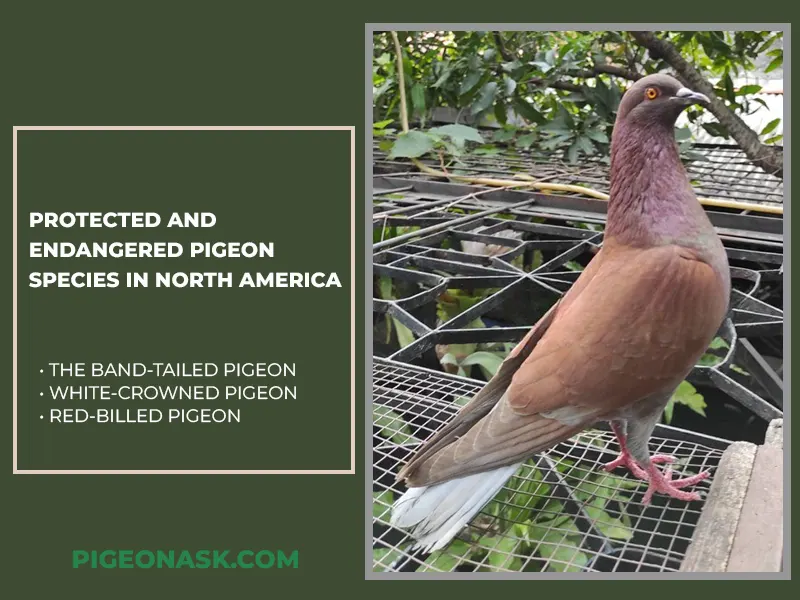
Here are some of the protected pigeon species in North America –
The Band-tailed Pigeon
This is a large, stocky pigeon native to the Americas and the largest native to North America. They are the continent’s closest genetic relative to the now-extinct Passenger Pigeon.
Band-tailed pigeons are found primarily in the western part of North America, from the south of British Colombia through Mexico and there is also a distinct population in Central America.
In some regions, habitat loss, hunting and other human activities have adversely affected their numbers. The band-tailed pigeon is listed as a species of special concern by the California Department of Fish and Wildlife.
Their number has significantly dropped 2% a year since 1968. This pigeon is also monitored for conservation status by organizations such as the U.S. Fish and Wildlife Service and the Canadian Wildlife Service.
White-Crowned Pigeon
It is native to the Caribbean and is found in the Bahamas, Cuba, the Cayman Islands, Puerto Rico and southern Florida in the United States. This species is known for its distinctive white crown, hence its name.
The White-crowned Pigeon is a medium to large-sized bird reaching up to 31.25 to 35.3 cm long and 225 to 232 g in weight. Its head and upper body are metallic blue-gray with a white crown and nape.
In North America, White-crowned Pigeons are yet another endangered species. Their range is restricted to the Florida Keys in the United States, where most of the population lives in Everglades National Park.
This species is of significant conservation interest due to declining populations.
Their number is estimated to be decreasing due to ongoing habitat degradation and unsustainable levels of hunting. Currently, it has a population of approximately 550,000 mature individuals.
This species is a State-designated Threatened species by Florida’s Endangered and Threatened Species Rule. The primary threats to its survival are habitat loss, hurricanes and excessive hunting.
Red-billed Pigeon
Found in the extreme southern areas of Texas and mostly in Mexico and Central America. This bird is protected under the Migratory Bird Treaty Act.
It is commonly seen along the lower half of the Rio Grande River in southeastern Texas, bordering Mexico and the U.S.
The species is known for its dark, slate-gray plumage with a maroon head, neck, wing coverts and red bill with a pale-yellow tip.
Habitat loss, pollution, disease, predation and human interference contribute to the decline of this pigeon population.
The IUCN Red List currently classifies the Red-billed Pigeon as the Least Concern, indicating that it is close to meeting the criteria for Vulnerable and there are concerns about its future.
While not yet classified as Endangered, the species is undoubtedly experiencing significant threats that could lead to further population declines if not addressed.
Key Takeaways
The legal approaches taken by both countries, although they have their peculiarities, have shown a keen interest in ensuring that urban wildlife, which includes pigeons, is managed in a moral and ethical manner.
In both countries, pigeons are often viewed under two contradictory lenses: as urban pests requiring control measures and as part of urban wildlife that warrants protection under certain circumstances.
And in the USA, the Migratory Bird Treaty Act provides protection for many bird species; however, feral and rock pigeons, being non-native, are generally excluded from such federal protection.
Canada’s approach to pigeon regulation similarly fluctuates across its territories and provinces.
The federal government provides protection to native bird species under the Migratory Birds Convention Act, but as in the USA, feral pigeons typically do not benefit from this legislation.
Both countries’ regulations tend to focus on preventing the negative impacts feral and rock pigeons can have on property, public spaces and potential disease transmission.
Future directions in pigeon-associated legislation and regulation in the USA and Canada may involve a greater emphasis on public education about humane wildlife interaction.
This approach will lead to the adoption of integrated pest management strategies that reduce reliance on lethal control and increase research into the ecological impacts of urban pigeon populations.
Wrapping Things Up
It is evident that legislation and regulations around pigeons in the USA and Canada are primarily designed to ensure the welfare of these birds, the safety of the public and the sustaining of the ecosystem.
As pigeons thrive alongside humans in cities, laws about them must adapt, reflecting the ongoing interaction between wildlife and urban life.
References:
- https://www.nbcenvironment.co.uk/about-us/articles/what-problems-do-pigeons-cause/
- https://blogs.loc.gov/law/2021/09/the-legal-history-of-pigeons/
- https://digitalcommons.unl.edu/cgi/viewcontent.cgi?article=1020&context=icwdmbirdcontrol
- https://file.lacounty.gov/SDSInter/ceo/rmo/1004730_pigeondiseases1.pdf
- https://www.nyc.gov/site/doh/health/health-topics/pigeon.page
- https://news.arizona.edu/blog/pigeons-present-public-health-concerns
- https://www.pigeonpatrol.ca/pigeons-are-considered-the-number-one-pest-bird-problem-in-the-united-states-and-around-the-world/
